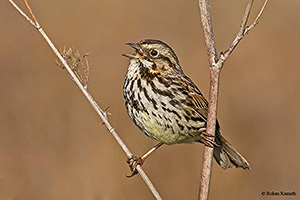Territoriality |
|
|---|---|

photograph of a Song Sparrow by Rohan Kamath |
Many
birds attempt to exclude other birds from all or part of
their home range -- the area they occupy in the course of
their normal daily activities. When they do, we say they are
defending a "territory." Most often this behavior occurs
during the breeding season and is directed toward members of
the same species. Territoriality appears, in most cases, to
be an attempt to monopolize resources, especially food
resources or access to mates. But territoriality may also
serve, in part, as a predator defense mechanism. Some birds defend their entire home range. Others defend only their food supply, a place to mate, or the site of their nest. Some tropical hummingbirds chase most other |
|
hummingbirds and other
nectar-feeding birds (and some butterflies) away from
favorite patches of nectar-bearing flowers. On their leks
(patches of ground traditionally used for communal mating
displays) grouse, some sandpipers, and some other birds
defend small territories.Most colonial-nesting seabirds
simply defend the immediate vicinity of their nests --
presumably to protect their eggs and, at least in the case
of some penguins, the pebbles from which the nest is
constructed. Territoriality tends to space some species of camouflaged birds and their nests rather evenly throughout their habitat; it prevents them from occurring in flocks or clusters while breeding. This, in turn, may reduce the danger from predation, since many predators will concentrate on one kind of prey after one or a few individuals of that prey type are discovered (that is, the predator forms a "search image"). Clustering can promote the formation of a search image by predators and thus reduce the security of each individual prey (birds that are not cryptic, however, may gain protection in clustering). To minimize the need for actual physical contact in order to defend territories, animals have evolved "keep-out" signals to warn away potential intruders. In birds, of course, the most prominent are the songs of males. Far from being beautiful bits of music intended to enliven the human environment (as was long assumed), bird songs are, in large part, announcements of ownership and threats of possible violent defense of an area. If, of course, the aural warning is ineffective, the territory owner will often escalate its activities to include visual displays, chases, and even combat. This territorial behavior is typically quite stereotyped, and can usually be elicited experimentally with the use of recorded songs or with stuffed taxidermy mounts. Territory size varies enormously from species to species, and even within species, from individual to individual. Golden Eagles have territories of some 35 square miles; Least Flycatchers' territories are about 700 square yards; and sea gulls have territories of only a few square feet in the immediate vicinity of the nest. Territory size often varies in the same species from habitat to habitat. In relatively resource-poor Ohio shrublands, Song Sparrows have territories several thousand square yards in extent. In the resource-rich salt marshes of the San Francisco baylands they are about one-fifth to one-tenth as large. The San Francisco birds need to defend much less area to assure an adequate food supply. |
|
| SEE:
Interspecific Territoriality;
Population Dynamics;
Vocal Dialects;
Vocal Functions. Copyright ® 1988 by Paul R. Ehrlich, David S. Dobkin, and Darryl Wheye. |
|